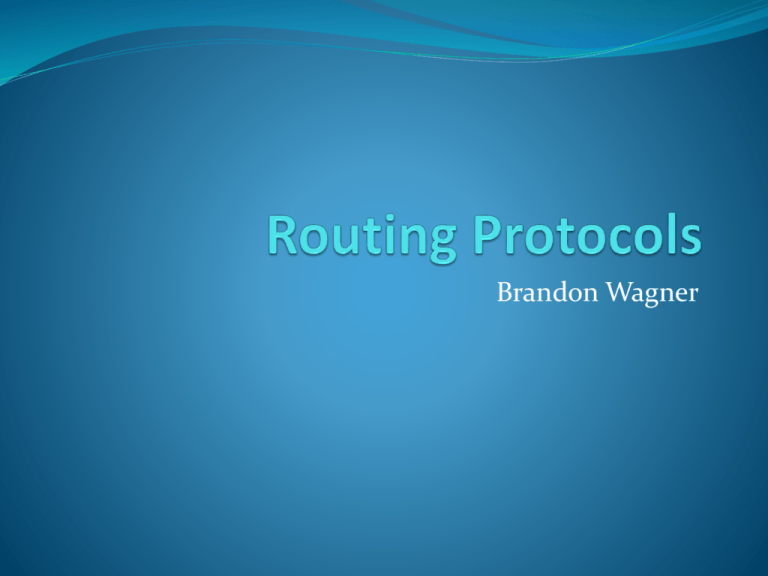Routing Protocols - IT 529 Advanced Networking
advertisement

Brandon Wagner Learning Outcomes Understand Interior and External Routing protocols and their differences Understand Distance-Vector and Link-State routing methods Describe the routing mechanisms of common routing protocols. What does a Routing Protocol do? Determine the best forwarding path from point A to point B. Prevent routing loops. Builds a routing table. Destination and gateway Two Types Interior Gateway Protocol Routing within an Autonomous System (AS) Exterior Gateway Protocol Routing between Autonomous System’s. Autonomous System Group of IP networks controlled by a single common administrator. Managed by IANA (Internet Assigned Numbers Authority) BYU has 1 assigned AS number. IGP: Interior Gateway Protocols Distance-Vector Routing Protocol Distance – the cost of reaching the destination. Vector – direction (which interface) to forward traffic. Information is only exchanged with neighbors. Examples RIP – Routing Information Protocol EIGRP – Enhanced Interior Gateway Routing Protocol Link-State Routing Protocol Link – the speed of the link (10 Meg / 100 Meg / 1 Gb / 10 Gb) State – Is the interface up or down? The whole network topology is known by every router Examples OSPF – Open Shortest Path First IS-IS – Intermediate System to Intermediate System Other Examples Distance-Vector: RIP Mechanism: Each router sends routing table to neighbor. Neighbor then forwards routing table to it’s neighbor. Algorithm: Bellman-Ford First Deployed: 1967 Cost: Hop Count Maximum # of hops is 15. Best Fit: Small networks with minimal changes. Distance-Vector: EIGRP Mechanism: Neighbor Table – List of all directly connected neighbors Topology Table – all available destination routes from neighbors Route Table – built from applying metric formula to Topology Table First Deployed: 1995 Cost: Delay, Bandwidth, Reliability, Load Best Fit: Enterprise Architecture Model Packet Types: Update, Query, Reply, Hello Sometimes called Hybrid – why? Link-State: OSPF Mechanism: Link State Advertisements (LSA) sent out to all other routers. Each router builds a LSDB The Database is converted into a weight graph. Each router determines shortest path to each other. Algorithm: Dijkstra’s Cost: Definable – bandwidth is commonly used. Best Fit: Very, very, VERY large networks. Split into network areas to reduce the size of update packets. Distance-Vector vs Link-State Distance Vector Pro’s Only have receive updates from neighbors. Simple to use and smaller overhead. Con’s Updates are spread node-by-node. Count-to-infinity problem. Link State Pro’s Each router has a full network topology. Convergence after a topology change is quicker. Con’s Requires more processing power and memory. EGP: Exterior Gateway Protocol BGP – Border Gateway Protocol Routes the internet The full route table is currently 357,000 path entries Path-Vector Routing Algorithm Tracks paths according to AS. Local preference determine best path to destination network. (Border Example) Does NOT track routes through individual routers. Routing Reviewed Questions?








